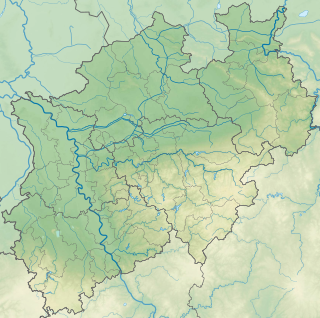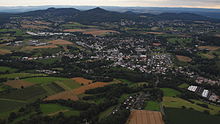Pleiser hill country
| Pleiser hill country | |||
|---|---|---|---|
| Systematics according to | Handbook of the natural spatial structure of Germany | ||
| Greater region 1st order | Low mountain range threshold | ||
| Greater region 2nd order | Rhenish Slate Mountains | ||
| Main unit group | 29 → Middle Rhine area |
||
| 4th order region (main unit) |
292 → Lower Middle Rhine Region |
||
| Natural space |
292.5 → Pleiser hill country |
||
| Geographical location | |||
| Coordinates | 50 ° 42 ′ 36 " N , 7 ° 16 ′ 40" E | ||
|
|||
| circle | Rhein-Sieg-Kreis , Bonn | ||
| state | North Rhine-Westphalia | ||
| Country | Germany | ||
The Pleiser Hügelland , more commonly known under the name Pleiser Ländchen , is a hilly landscape up to a good 235 m high in southern North Rhine-Westphalia in the Rhein-Sieg district and in the east of the city of Bonn , which extends the up to 461 m high Siebengebirge to the north and northeast as well the nearby around 300 m reach Lower Westerwald to the northwest abdacht. Flowed through by the Pleisbach and Hanfbach , it meets the valley of the Sieg in the north and the valley of the Rhine in the northwest with its partial landscape Ennert .
The Pleiser Ländchen, apart from the wooded Ennert ridge, is mainly used for arable farming.
Natural classification
In terms of nature , the Pleiser Hügelland - like the Siebengebirge (292.4) to the west - belongs to the main unit of the Lower Middle Rhine Region (292), the extreme north-east of which it occupies, and bears the code number 292.5. The north-west adjoining valley of the Rhine and the valley of the Sieg to directly above Hennef , which adjoins it in the west, are already partial landscapes of the Cologne Bay (main unit 551), the Middle Siegtal (330.1) above Hennef is part of the Mittelieg-Bergland (main unit 330 ) and the Asbacher plateau (324.80) adjoining it to the southeast is part of the Niederwesterwald (324).
geology
The sunken deeply through, pointing to the northwest Box valleys of hemp and Pleisbach and their tributary streams embossed Pleiser hills with loess , loess loam and tuffs covered. Besides playing bench gravel and tertiary sands and clays a certain role. This structure is interrupted by occasional basalt breakthroughs. In and around the Ennert part of the landscape, lignite mining with alum extraction was carried out intensively between 1809 and 1875.
places
The Pleiser Ländchen is located in its north-west in the Bonn district of Beuel and takes the districts of Hoholz , Holtorf (with Oberholtorf, Niederholtorf and Ungarten) and Holzlar (with Kohlkaul, Roleber, Gielgen and Heidebergen) with the Ennert .
The majority of the Pleiser Ländchen is in the Rhein-Sieg district and there in its southwest in the northeast of the city of Königswinter and in its northeast in the southwest of the city of Hennef and in the southeast of the city of Sankt Augustin .
In addition to the urban area of Bonn and the transition to the Siegtal, the districts of Königswinter Thomasberg and (on the Ölberg ) Ittenbach in the south, on the edge of the Siebengebirge, and on the other side of the A3 Oberpleis are more densely populated .
Natural parks and nature reserves
The west of the Pleiser Ländchen belongs to the Siebengebirge Nature Park , the east to the Bergisches Land Nature Park . The Königswinter district of Oberpleis in the south is not in any nature park.
The predominantly wooded Ennert ridge is part of the Siebengebirge nature reserve ( Ennert sub-area ). In the northeast, the valley of the Adscheider Baches is part of the NSG Ahrenbachtal and Adscheider Tal , which extends to the north of the Asbach plateau. Smaller nature reserves are the NSG Eisbachtal with shallow depths at Oberpleis, the "NSG Pleisbach" (SU-100) and to the north the "NSG Rotter Hardt and Morbach" (SU-103), in the south and west the edge areas of the Pleis hill country also belong to the core area of the 1922 formed "NSG Siebengebirge".
mountains
The more distinctive elevations of the Pleiser Hügelland include:
- Limperichsberg (a good 235 m , between Thomasberg and Heisterbacherrott ), former quarry
- Scharfenberg ( 233 m , north of Thomasberg), former quarry
- Löhberg ( 220.4 m , north of Hartenberg )
- Hinsberg ( 201.2 m , northwest of Oberpleis )
-
Ennert (up to 195.3 m , extreme west)
- Paffelsberg ( 195.3 m , south)
- Ennert ( 152 m , extreme north (west) en) in the mountain range of the same name and part of the landscape.
Rivers
The most important and at the same time only noteworthy flowing waters of the Pleiser Hügelland are the Pleisbach and the Hanfbach , both of which flow to the north (north) west of the Sieg .
literature
- Heinrich Müller-Miny: The Middle Rhine region and its natural structure . In: Federal Institute for Regional Studies (Ed.): Reports on German Regional Studies . Volume 21, Issue 2 (September 1958), self-published by the Federal Institute for Regional Studies, Remagen 1958, pp. 193–233 (here: pp. 230–232). [not yet evaluated for this article]
- Institute for Regional Studies (ed.); Heinrich Müller-Miny (arrangement): Geographical and regional explanations for the topographical map 1: 50000 . 1. Delivery, self-published by the Federal Institute for Regional Studies and Spatial Research, Bad Godesberg 1963, p. 29. [not yet evaluated for this article]
Web links
Individual evidence
- ↑ a b Ewald Glässer: Geographical land survey: The natural spatial units on sheet 122/123 Cologne / Aachen. Federal Institute for Regional Studies, Bad Godesberg 1978. → Online map (PDF; 8.7 MB)
- ↑ Heinz Fischer: Geographical Land Survey: The natural spatial units on sheet 124 Siegen. Federal Institute for Regional Studies, Bad Godesberg 1972. → Online map (PDF; 4.1 MB)
- ↑ BfN - landscape profile 29203 Pleiser Hügelland and Siebengebirge
- ↑ a b map services ( memento of the original from December 19, 2012 in the Internet Archive ) Info: The archive link was inserted automatically and has not yet been checked. Please check the original and archive link according to the instructions and then remove this notice. of the BfN
- ↑ http://nsg.naturschutzinformationen.nrw.de/nsg/de/fachinfo/gebiet/angebote/SU_001K2
- ↑ http://nsg.naturschutzinformationen.nrw.de/nsg/de/fachinfo/gebiet/angebote/SU_100

